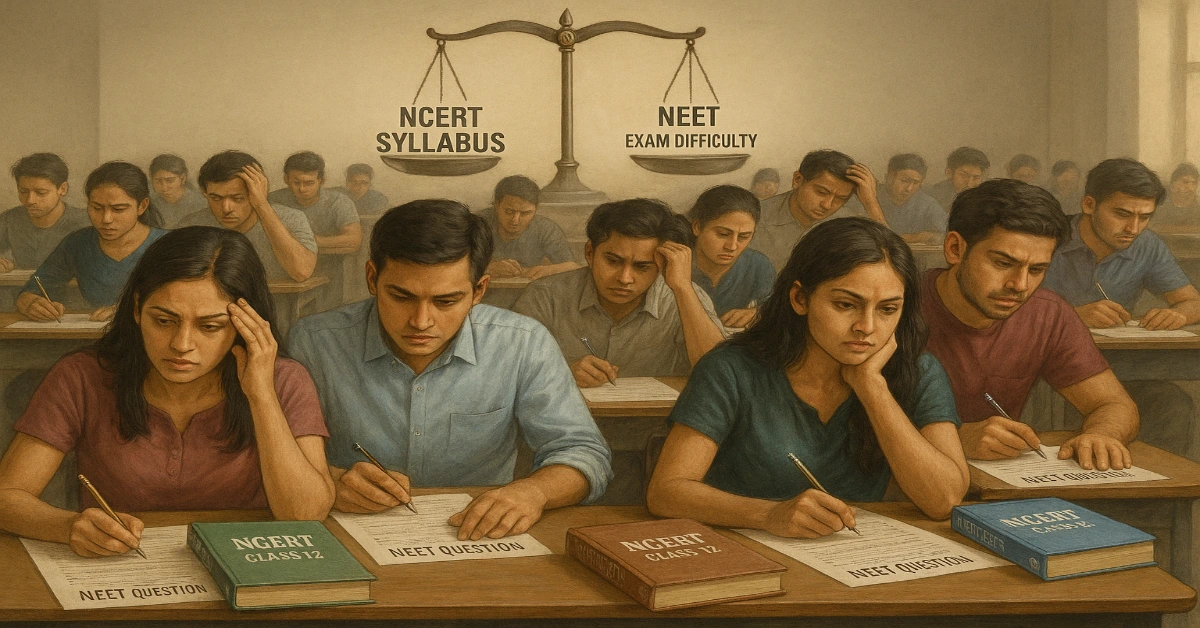NEET UG 2026: The National Eligibility cum Entrance Test (NEET) examination decides the future of millions of aspirants every year. For lakhs of families, these exams are not just tests, they are gateways to prestigious careers in medicine. The debate surrounding their difficulty level and alignment with the Class 12 syllabus has once again come into the spotlight following the controversy surrounding the NEET UG 2025.
The Centre has now tasked an expert panel with reviewing whether exams like NEET UG 2026 should be “better aligned” to the Class 11 & 12 curriculum. But what does this alignment mean, why is it being considered, and what trade-offs does it involve?
Why is the Debate Back in the Spotlight?
The NEET UG 2025 exam was tougher than the general trends, which many students and teachers described as unusually difficult. Physics in particular drew heavy criticism:
- Students said it was tougher and more time-consuming than in previous years.
- Some complained about ambiguous or out-of-syllabus questions.
- Technical and administrative glitches at exam centres added to the frustration.
Students, parents, and even some coaching institutes argued that NEET had deviated from the NCERT Class 11-12 syllabus it is meant to test. This, they claimed, forced students to depend even more heavily on expensive coaching.
Upon this, the Ministry of Education set up an expert panel in June 2025. The panel’s mandate is wide:
- Examine the impact of the coaching culture and the rise of dummy schools
- The government is also framing policy to reduce coaching dependence and gummy schooling culture plaguing the NEET system, affecting millions of disadvantaged students.
- Assess whether the exams are fair and effective.
- Analyse data to see if difficulty levels align with the Class 12 curriculum.
This means that the issue is no longer just a matter of student complaints; it is now the subject of formal policy review at the highest level.
Read Also: NEET UG 2026 May Shift to Computer-Based Test (CBT): What Students Need to Know
What Does “Align with Class 12 Syllabus” Actually Mean?
When policymakers talk about alignment, they do not mean one single thing. In fact, the phrase has three distinct interpretations:
Content Alignment
- Ensuring that all questions are based strictly on topics in the NCERT or state board syllabi.
- No off-syllabus items like advanced calculus in NEET, or university-level problem-solving in JEE.
Cognitive Level Alignment
- Restricting the exam to test knowledge, understanding, and application.
- Avoiding ultra-complex, puzzle-style problems that are not representative of what is taught in Class 12.
Difficulty Calibration
- Designing papers so that the overall difficulty distribution matches what a well-prepared Class 12 student can attempt.
- This means balancing easy, moderate, and hard questions instead of overloading the paper with tricky ones.
Any policy to “align” the exams could target one or more of these areas. But the technical, political, and educational implications of each are very different.
Read Also: NEET UG Syllabus 2026 by NTA: Download Subject-Wise Syllabus in PDF
Why the Centre is Considering This
The arguments for and against alignment reflect deep concerns about equity, rigour, and fairness.
Arguments For Alignment
Equity: If exams require coaching tricks or off-syllabus knowledge, students from regular schools, especially rural or government schools, are disadvantaged. Alignment levels the playing field.
Mental Health: Ultra-difficult papers fuel stress, anxiety, and the sense that coaching is unavoidable. Aligning with Class 12 could ease the mental health burden.
Policy Coherence: NEET and JEE were always meant to test Class 11-12 knowledge. Staying true to that purpose avoids confusion about what exactly students are expected to study.
Arguments Against Alignment
Selection Rigour: Medical and engineering education is highly competitive. Some experts argue that exams must test problem-solving and analytical skills, not just recall of textbook knowledge.
Differentiation at Scale: With over 20 lakh NEET candidates, the exam must include hard items to spread scores across a wide range. A paper that is too easy to compress scores and makes ranking less reliable.
Coaching Adaptability: Even if exams are simplified, the coaching industry can adapt quickly. Instead of disappearing, it may simply redesign its curriculum around the new exam blueprint.
NEET UG 2026: The Technical Hurdles
Changing exam design is not as simple as issuing a government directive. It involves complex technical and psychometric work:
- Blueprinting: NTA (National Testing Agency) must set the percentage of questions at each difficulty and cognitive level.
- Item Bank Development: Thousands of new questions must be written, reviewed, and pre-tested to build a reliable question pool.
- Equating and Scaling: If difficulty changes, NTA must ensure that scores remain comparable across years. Without this, cutoffs and admissions could be distorted.
- Validity Studies: Researchers must prove that the redesigned exams still predict medical/engineering performance. Otherwise, student quality could be at risk.
This is why the panel is still in an analysis phase rather than rushing into reforms.
NEET UG 2026: Possible Recommendations
What might the panel realistically propose? Based on international best practices and Indian debates, a few likely measures are:
- Tighter Syllabus Enforcement: Ban off-syllabus questions and strengthen review processes.
- Blueprint Rebalancing: Increase the weight of Class 12, level application questions while reducing puzzle-heavy items.
- Transparency Measures: Publish a detailed blueprint and sample papers to reduce the coaching industry’s monopoly on “insider knowledge.”
- Phased Implementation: Pilot new formats in mock exams or optional trials before rolling them out in the main exam.
- Coaching and Dummy School Regulation: Address the root of inequity by regulating exploitative coaching practices alongside exam changes.
Read Also: NEET UG 2026 Exam: What Changes Students Can Expect?
What NEET UG 2026 Aspirants Should Do
For students preparing now, the key message is: don’t panic. Major overhauls will take time.
- Focus on NCERT/Class 12 Syllabus: Build strong fundamentals in Biology, Chemistry, and Physics.
- Balance Practice: Continue solving higher-order questions, but prioritise conceptual clarity and time management.
- Stay Updated: Keep yourself updated on the neet.nta.nic.in and the Ministry of Education. Ignore unverified coaching rumours about exam changes.
The most likely scenario for 2026 is incremental reform, such as stricter syllabus checks or clearer paper blueprints, not a complete redesign.
The Risks and Trade-offs
The government and panel face difficult choices:
- Fairness vs. Rigour: Easier exams increase accessibility but may weaken the ability to identify top performers.
- Short-term vs. Long-term Impact: Sudden changes could disadvantage current students; gradual changes balance stability and reform.
- Coaching Dynamics: Lowering difficulty won’t automatically end coaching dependence; broader reforms in school education and guidance are needed.
Change Will Be Cautious, Not Abrupt
The Centre’s move to review exam alignment shows that student voices after NEET UG 2025 have been heard. However, exam design is a complex ecosystem. Policymakers must balance equity, mental health, academic standards, and technical feasibility before making changes.
Students should expect cautious, evidence-driven reforms, starting with stricter syllabus checks, clearer blueprints, and phased pilot testing. Sweeping changes are unlikely in the immediate future.
For NEET UG 2026 aspirants, the best preparation remains unchanged: master NCERT, build strong fundamentals, practice smartly, and stay adaptable.


